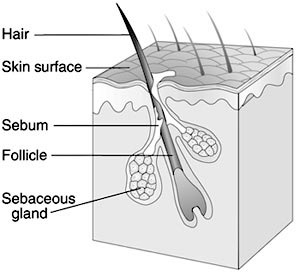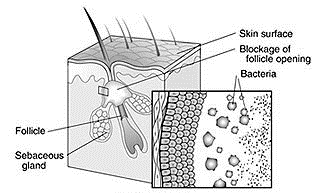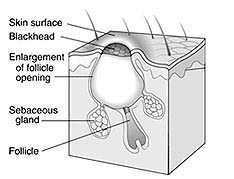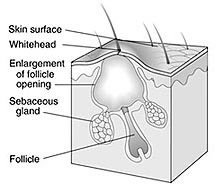
Acne Causes
The most important cause of acne or pimples is infection of the hair follicles. As a child attains puberty the levels of sex hormones begin to rise. These stimulate the secondary sexual characteristics like development of hair in the armpits and groin and deepening of voice.
The hormones also bring about significant changes in the skin. These hormones stimulate several glands in the skin called sebaceous glands to produce more oil, also called sebum. Sebum is primarily released through the hair shaft onto the skin. Its main function is to lubricate and protect the skin.
 |
The skin and hair follicles contain several harmless bacteria. These are generally called commensal organisms. Their presence is not infective in a normally healthy person. When there is excessive production of sebum, it combines with the dead cells that are shed regularly from the top layer of the skin. This combination forms a plug in the skin pore called a comedone.
A comedone or plugged follicle eventually ruptures. This leads to the leakage of the sebum into the surrounding skin causing inflammation. The commensal bacteria on the skin can break down the fatty parts of the sebum into fatty acid substances. These also leak into the surrounding skin causing inflammation.
The result of this pathological process is formation of a solid bump or a pustule over the surface of the skin or formation of a cyst (fluid filled sac) within the skin. The solid bump over the skin is called a whitehead.
Alternatively, the plugged follicle can be open to the skin, creating a blackhead. Bacterial infection of the whitehead or blackhead may give rise to papules, pustules, nodules or cysts.
 |
 |
 |
Factors that raise the risk of acne
- Age – adolescence or puberty is a risk factor for developing acne. The sebaceous glands are particularly sensitive to hormones. Raised levels of testosterone (male sex hormone) leads to the secondary sexual changes and reproductive development of the boys. In girls the levels of testosterone also rise during puberty but to a much lower extent. This helps in bone and muscle growth. Increased levels of testosterone cause the glands to produce much more sebum than the skin needs.
- Familial trait – those with parents who have suffered from acne are more likely to get acne.
- Oily skin – increased oiliness of the skin is most likely the result of increased sebum secretion
- Hormonal changes - some women have a flare-up of acne just before their periods. This indicates a hormonal association. Similarly acne may me more severe in some pregnant women especially during the first three months of their pregnancy.
- Hormonal disorders – women with hormonal disease like Polycystic ovary syndrome are more likely to get acne
- Acne may also be a result of side effects of certain drugs like steroids, lithium (taken for bipolar disorder or depression).
- Acne is not caused by poor diet or a diet rich in spices and oils. Eating a healthy, balanced diet is recommended however.
- Acne is not caused by lack of cleanliness. Although not cleaning the affected or prone areas leads to accumulation of sebum and dirt in susceptible persons raising risk of acne.
- Acne is not caused by sexual activity or masturbation. Acne is also not caused or worsened by sunbeds and sunlamp exposure. Artificial tanning beds however should be avoided as they raise the risk of skin cancer.
Sources
Further Reading
Last Updated: May 29, 2019






















.png)










No hay comentarios:
Publicar un comentario